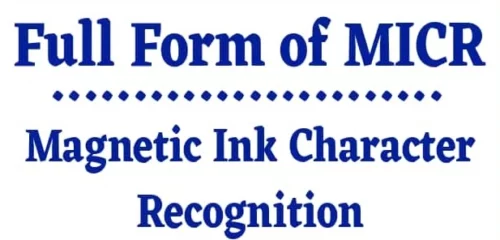MICR full form is “Magnetic Ink Character Recognition“. It is a technology used in the banking industry for processing and authenticating checks. MICR involves printing a specific pattern of characters on the bottom of checks and other financial documents using magnetic ink. In this article we will tell you about “MICR Full Form: Components, Importance, Benefits and more”.
Overview
“Magnetic Ink Character Recognition (MICR) stands as a pivotal innovation in modern finance and document processing. By integrating magnetic ink into printed characters, MICR facilitates automated reading and verification of essential information such as account numbers and routing codes. This technology, predominantly used in checks and financial documents, enhances efficiency by enabling high-speed, accurate scanning and processing. With its enduring presence, MICR continues to exemplify the synergy between technological advancement and the critical realm of financial transactions.”
Know further about this article “MICR Full Form: Components, Importance, Benefits and more” below.



Components
- Magnetic Ink
- Character Set
- E-13B Font
- Magnetic Fonts and Printing
- Positioning and Alignment
- Magnetic Sensors
- Signal Processing Software
- Verification
- Document Processing
- Security Measures
- MICR Line
History of MICR Technology
| Era | Milestones and Developments |
|---|---|
| 1950s | – Early concepts of MICR emerged for automating check processing. |
| – The American Bankers Association (ABA) initiated MICR standardization. | |
| 1956 | – Stanford Research Institute (SRI) developed the E-13B font. |
| – First implementation of MICR in banks, improving check processing. | |
| 1960s | – Adoption of MICR expanded, replacing manual data entry. |
| – Banking industry embraced MICR for its accuracy and efficiency. | |
| 1970s | – MICR technology integrated with computer systems for data handling. |
| – Usage extended beyond checks to various financial documents. | |
| 1980s | – MICR technology refined for higher accuracy and reading speeds. |
| – Implementation in various sectors beyond banking, such as retail. | |
| 1990s | – Continued improvements in MICR reading devices and software. |
| – Enhanced security features introduced to combat fraud. | |
| 2000s | – MICR technology remains a cornerstone of financial processing. |
| – Shift towards digital payments and reduced paper checks. | |
| Present | – MICR technology remains vital for processing paper-based documents. |
| – Continuous integration with evolving digital banking systems. |
Importance of MICR in Banking
- Efficient Check Handling: MICR technology revolutionizes check processing, enabling banks to quickly and accurately manage a high volume of checks.
- Error Reduction: Automation through MICR reduces human errors in data entry, ensuring accurate transaction processing.
- Swift Transaction Processing: MICR expedites transaction processing, enabling faster fund availability for customers.
- Automated Sorting and Routing: MICR-encoded information facilitates automated sorting and routing of checks, optimizing the clearing process.
- Enhanced Security: Unique MICR encoding with magnetic ink and standardized font deters check fraud and alterations.
- Integration with Digital Systems: MICR ensures smooth coexistence between paper-based and digital processes in the evolving banking landscape.
- Legacy Continuity: Despite digital trends, MICR accommodates the use of paper checks, preserving efficiency and accuracy.
- Verification and Auditing: Standardized MICR format enables easy and reliable verification and auditing of transactions.
Benefits of MICR Encoding
1. Accuracy and Reliability: MICR encoding ensures high accuracy in reading characters, minimizing errors and ensuring reliable data capture during transaction processing.
2. Efficient Check Processing: Banks can swiftly process a significant volume of checks due to the automated nature of MICR, reducing processing time and enhancing customer experience.
3. Secure Transactions: The unique combination of magnetic ink and specialized font makes MICR-encoded data resistant to alterations and forgeries, enhancing security.
4. Automated Sorting and Routing: MICR-encoded information aids automated sorting and routing of checks, optimizing the check clearing process and reducing manual intervention.
5. Smooth Integration: MICR seamlessly integrates with existing banking systems, facilitating the transition between paper-based and digital processes.
6. Enhanced Audit Trails: MICR encoding provides a standardized and easily verifiable format for transaction records, contributing to efficient auditing processes.
7. Cost Efficiency: Automation through MICR reduces manual labor and errors, leading to cost savings and operational efficiency for financial institutions.
8. Legacy Continuity: In an era of digital transformation, MICR accommodates the continued use of paper checks, ensuring consistent service for diverse customer preferences.
Innovations
- Advanced Magnetic Inks: Innovations in magnetic ink formulations have led to improved readability and increased resistance to environmental factors. These inks are designed to maintain their magnetic properties over extended periods.
- High-Speed Scanning Technology: Modern scanning devices equipped with advanced sensors and image processing capabilities can read MICR-encoded characters at higher speeds, enhancing overall efficiency.
- Intelligent Character Recognition (ICR) Integration: Some systems now combine MICR with ICR, allowing for the recognition of both printed and handwritten characters on checks and documents.
- MICR Line Placement Verification: Innovations in MICR line placement verification technologies ensure that characters are accurately aligned within specified zones on documents, reducing errors in reading.
- Mobile MICR Reading: Mobile apps equipped with MICR reading capabilities allow individuals and businesses to scan checks using their smartphones, transforming them into electronic transactions.
- Enhanced Security Features: Modern MICR technology incorporates advanced security features, such as UV ink and encrypted encoding, to prevent counterfeiting and fraud.
- Real-Time Verification: Real-time MICR verification tools instantly validate encoded data during the scanning process, reducing the chances of errors and fraudulent activities.
- Cloud Integration: MICR technology is increasingly integrated into cloud-based systems, enabling remote check deposit and processing, even in online banking environments.
FAQs about MICR
Yes, individuals and businesses can use MICR technology for personal check printing and remote deposit capture using mobile apps.
Yes, MICR technology remains relevant due to its efficiency in processing paper-based financial documents. It also facilitates the transition between paper-based and digital processes.






